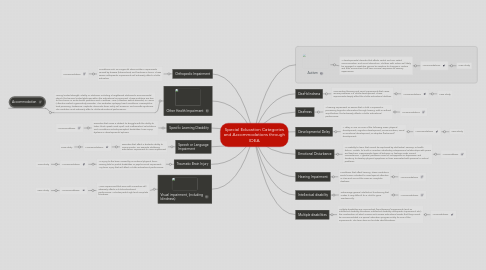Special Education Categories and Accommodations through IDEA
저자: Josh Barr


1. Orthopedic Impairment
1.1. Conditions such as congenital abnormalities, impairments caused by disease (tuberculosis) and fractures or burns. These severe orthopaedic impairments will adversely affect a child’s education
1.1.1. Accommodations
2. Other Health Impairment
2.1. Having limited strength, vitality, or alertness, including a heightened alertness to environmental stimuli, that causes limited alertness within the educational environment. These problems are due to the chronic or acute health problems such a asthma, ADD (Attention Deficit Disorder) or ADHD (Attention Deficit Hyperactivity Disorder. Also Diabetes, epilepsy, heart conditions, Haemophilia, lead poisoning, leukaemia, nephritis, rheumatic fever, sickly cell anaemia, and Tourette syndrome. The condition must adversely affect a child’s educational performance.
2.1.1. Accommodation
3. Specific Learning Disability
3.1. Disorders that cause a student to struggle with the ability to listen, think, speak, read, spell, and mathematical calculations. Such conditions include perceptual disabilities, brain injury, dyslexia or developmental aphasia.
3.1.1. Accommodations
4. Speech or Language Impairment
4.1. Disorders that affect a student’s ability to communicate. For example stuttering, articulation impairment or voice impairment
4.1.1. Accommodations:
4.1.1.1. Case Study
5. Traumatic Brain Injury
5.1. An injury to the brain caused by an external physical force, causing total or partial disabilities or psycho-social impairment. Any brain injury that will affect a child’s educational performance.
5.1.1. Accommodations:
5.1.1.1. Case Study
6. Visual impairment, (including blindness)
6.1. Vision impairment that even with correction still adversely affects a child’s educational performance. Includes partial sight and complete blindness.
6.1.1. Accommodations:
6.1.1.1. Case Study
7. Autism
7.1. A developmental disorder that affects verbal and non verbal communication, and social interaction. Children with autism will likely be engaged in repetitive games, be resistive to changes in routine and their environment and have unusual responses to sensory experiences.
7.1.1. Accommodations
7.1.1.1. Case Study
8. Deaf-blindness
8.1. Concomitant hearing and visual impairments that cause severe problems in a child’s development. These impairments deeply affect the child’s educational abilities.
8.1.1. Accommodations
8.1.1.1. Case Study
9. Deafness
9.1. A hearing impairment so severe that a child is impaired in processing linguistic information through hearing, with or without amplification, that adversely affects a child’s educational performance.
9.1.1. Accommodations
10. Developmental Delay
10.1. A delay in one or more of the following areas: physical development; cognitive development; communication; social or emotional development; or adaptive [behavioral] development.
10.1.1. Accommodations
10.1.1.1. Case Study
11. Emotional Disturbance
11.1. An inability to learn that cannot be explained by intellectual, sensory, or health factors. Unable to build or maintain satisfactory interpersonal relationships with peers and teachers. Inappropriate types of behavior or feelings under normal circumstances. A general pervasive mood of unhappiness or depression and tendency to develop physical symptoms or fears associated with personal or school problems.
11.1.1. Accomodations
12. Hearing Impairment
12.1. Conditions that affect hearing. These conditions would cause a student to need special attention in class and are not the same as complete deafness.
12.1.1. Accommodations
13. Intellectual disability
13.1. subaverage general intellectual functioning that makes it very difficult for a child to grow academically .
13.1.1. Accommodations
14. Multiple disabilities
14.1. Multiple disabilities are concomitant [simultaneous] impairments (such as intellectual disability-blindness, intellectual disability-orthopedic impairment, etc.), the combination of which causes such severe educational needs that they cannot be accommodated in a special education program solely for one of the impairments. The term does not include deaf-blindness.
14.1.1. Accomodations
